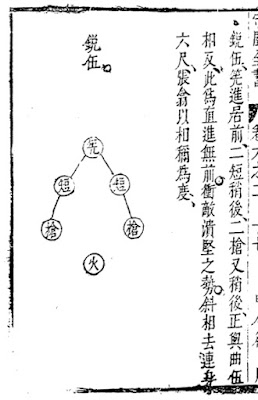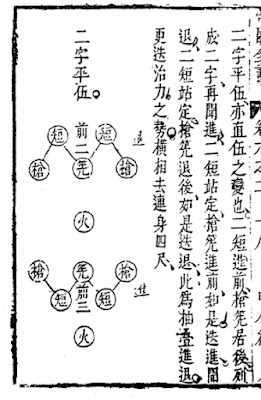 |
| Portrait of Xu Guang Qi currently kept at Guangqi Park, Shanghai. |
The army that never was
Xu Guang Qi envisioned a small but elite hundred thousand strong standing army (later lowered to sixty thousand) that was able to face the increasing dire Manchu threat. The army would be spread out to defend the Nine Garrisons, but still able to muster quickly for a counterthrust into Manchu territories.
After the disastrous Battle of Sarhu, Xu Guang Qi made repeated requests to raise a new army. His request was approved in 1619, and he was appointed to raise and train a new army in Tongzhou and Changping. However, Xu Guang Qi faced strong opposition from within the Ming court, and Ming Dynasty was already in terrible shape economically, so his plan did not go as smoothly as he hoped. Later Xu Guang Qi's deteriorating health forced him to gave up the plan. He would attempt to raise another army through his student Sun Yuan Hua (孫元化), but that plan also resulted in failure.
Equipment
Xu Guang Qi was aware that existing Ming armours offered inadequate protection against powerful Manchu bows and lances. He envisioned an extremely well-armoured Ming army that could stand up to Manchu threat and eventually defeat them. Every troopers in the new army would be protected by a complete suit of polished iron armour consisted of body armour, thigh armour, helmet, armoured mask, neck guard (aventail), spaudlers, mirror plate, armguards and belt, supplemented by leather blanket (cloak) and cloth padding. The army did not use shields except free-standing Ai Pai (挨牌).
Xu Guang Qi also divided the weaponry of the new army into four categories:
- Yuan Qi (遠器, ranged weapon): Xu Guang Qi required that every troops, including porters and supporting personnels, to be armed and trained with an arquebus or musket. He also banned all handgonnes and other less effective firearms, but still allowed some bows and arrows.
- Chang Qi (長器, long weapon): Only Chang Qiang (長鎗) and Lang Xian (狼筅) were considered long weapon.
- Duan Qi (短器, short weapon): All polearms shorter than Lang Xian were considered short weapon. Polearms in the new army included Chang Bing Ti Dao (長柄剔刀, Chinese equivalent of naginata (なぎなた or 薙刀), bladed quarterstaves, Gou Lian Qiang (鈎鐮鎗), Tang Pa (鎲鈀) and tiger forks, all standardised to nine chi long.
- Duan Dao (短刀, short sabre):Xu Guang Qi specified that every troops must be armed with a short sabre as sidearm.
Organisation
Referencing earlier Ming armies, Xu Guang Qi laid out a detailed organisational framework for his new army.
Table below provides an overview to the structure of the army:
Military unit
|
Rough modern equivalent
|
Troop
|
Porter |
Support personnel
|
Total
| Leader |
Da Jun (大軍)
|
Division
|
13,280+1*
|
2500
|
975+494
|
17,250/
5 Ying |
Da Jiang (大將) |
Ying (營)
|
Regiment
|
2,655+1*
|
500
|
195+99
|
3,450/
5 Bu |
Jiang Guan (將官)
|
Bu (部)
|
Battalion
|
530+1*
|
100
|
20+19
|
670/
5 Shao |
Qian Zong (千總)
|
Shao (哨)
|
Company
|
105+1*
|
20
|
4
|
130/
5 Dui |
Shao Zong (哨總)
|
Dui (隊)
|
Platoon
|
20+1*
|
4
|
-
|
25/
5 Wu |
Dui Zhang (隊長)
|
Wu (伍)
|
Team
|
4+1*
|
-
|
-
|
5
|
Wu Zhang (伍長)
|
While himself a scholar, Xu Guang Qi scoffed at the practise of treating soldiers as lower class or social outcast. He called for proper treatment of soldiers, and designed the military hierarchy in the new army accordingly. All men aged between sixteen and forty were eligible to join, and promotion was based on merit.
Table below provides an overview to the military ranks of the army:
Military rank
|
Literal meaning
|
Rough modern equivalent
|
Monthly salary
(in silver) |
| Jiang Ling (將領)* | General | Colonel |
Varies
|
| Qian Ba Zong (千把總)* |
Thousand Captain
|
Lieutenant Colonel
|
Varies
|
| Shao Guan (哨官)* Dui Zhang (隊長)* |
Watch Officer
Platoon Leader
|
Captain
Lieutenant
|
Varies
|
| Shang Shi (上士) |
Sergeant
|
Corporal
|
3 tael
|
| Zhuang Shi (壯士) |
Strongman
|
Lance Corporal
|
2 taels 4 maces
|
| Feng Bing (鋒兵) |
Sharp/Elite Soldier
|
Private First Class
|
1 taels 8 maces
|
| Dui Bing (隊兵) |
Squad Soldier
|
Private
|
1 tael 2 maces
|
Tactics
Like many Ming armies, all troopers of Xu Guang Qi's army served as dual role unit, armed with both arquebuses and pikes or polearms.
Xu Guang Qi designed five basic formations (with several variant sub-formations) for his army. These formations were Fang Zhen (方陣, square formation), Qu Zhen (曲陣, crooked formation), Yuan Zhen (圓陣, round formation), Zhi Zhen (直陣, straight/column formation) and Rui Zhen (銳陣, sharp/wedge formation). All formations were simple, straightforward and easily scalable.
Fang Wu (方伍, square team)
 |
| Layout of a Fang Wu, from 'Xuan Lian Tiao Ge (《選練条格》)'. |
The porter also carried a spade (that doubles as carrying pole and quarterstaff).
Every troopers, including the porter, was armed with an arquebus, but some troops could switch to bows and arrows instead. After shooting, team leader and pikemen would pass their arquebuses to the porter and prepare for close combat.
Yuan Wu (圓伍, round team)
Round formation was not applicable to Wu-level unit, as five troopers were too few to form a proper circle.
Qu Wu (曲伍, crooked team)
 |
| Basic layout of a Qu Wu, from 'Xuan Lian Tiao Ge (《選練条格》)'. |
Zhi Wu (直伍, straight team)
 |
| Basic layout of a Zhi Wu, from 'Xuan Lian Tiao Ge (《選練条格》)' |
Rui Wu (銳伍, sharp team)
 |
| Basic layout of a Rui Wu, from 'Xuan Lian Tiao Ge (《選練条格》)' |
Yi Zi Ping Wu (一字平伍, lit. ''One' ideograph horizontal team')
 |
| Basic layout of a Yi Zi Ping Wu, from 'Xuan Lian Tiao Ge (《選練条格》)'. |
Er Zi Ping Wu (二字平伍, lit. ''Two' ideograph horizontal team')
 |
| Layouts of Er Zi Ping Wu, from 'Xuan Lian Tiao Ge (《選練条格》)'. |
Er Zi Ping Wu was another variant formation of Zhi Wu. In this formation, the team deployed in two ranks. Two polearm troops formed the first rank, the team leader and two pikemen formed the second rank. The formation would advance or retreat in "waves", i.e. the first rank would stand its ground and wait for the second rank to move past it, and vice versa.
This formation was possibly used to facilitate a primitive version of "fire and manoeuvre" tactics.
Other blog posts in my De Sheng Bing series:
Xu Guang Qi's De Sheng Bing — Part 1
Xu Guang Qi's De Sheng Bing — Part 2
Xu Guang Qi's De Sheng Bing — Part 3-1
Xu Guang Qi's De Sheng Bing — Part 3-2
Xu Guang Qi's De Sheng Bing — Part 4
Xu Guang Qi's De Sheng Bing — Part 5
In Lianbingshiji, I found out about this item which is related to the Huobing 火兵 of the cavalry and infantry department: "火擔者,火兵也。擔,扁挑也。用鐵尖扁擔,便於肩挑,又可擊刺,亦農中戰器也"
ReplyDelete"火兵;每名鐵尖扁擔一根". Do you know what is this weapon/item? I saw a depiction of it in the 部队图 in Lianbingshiji, but I don't know what it is.
鐵尖扁擔 is just a carrying pole sodded with an iron spike.
Delete